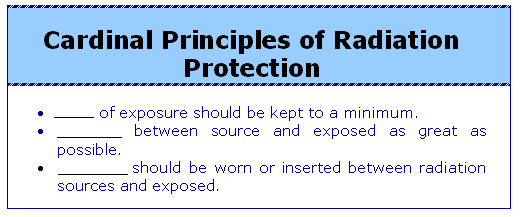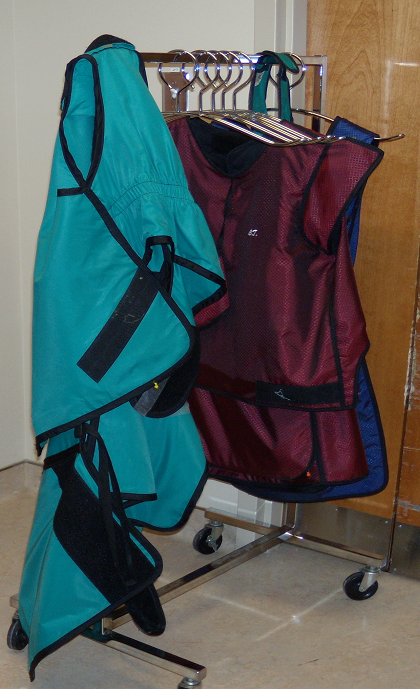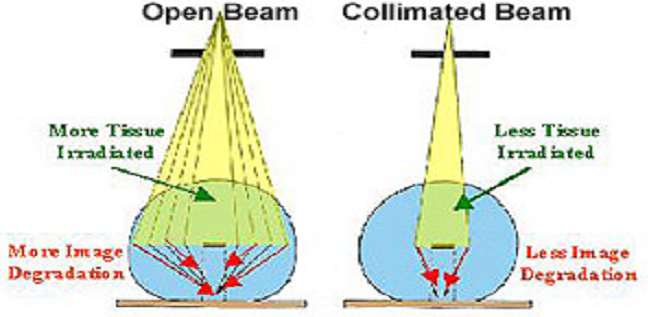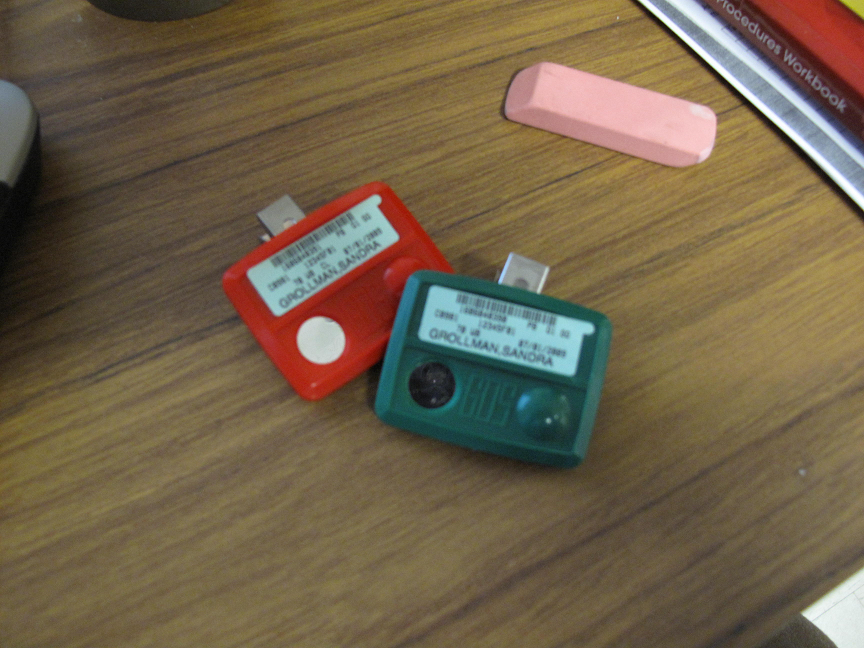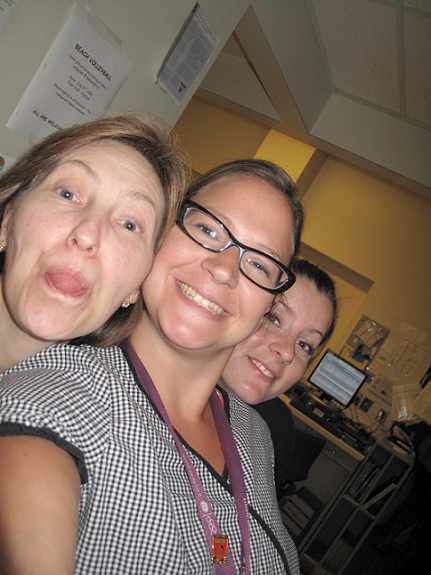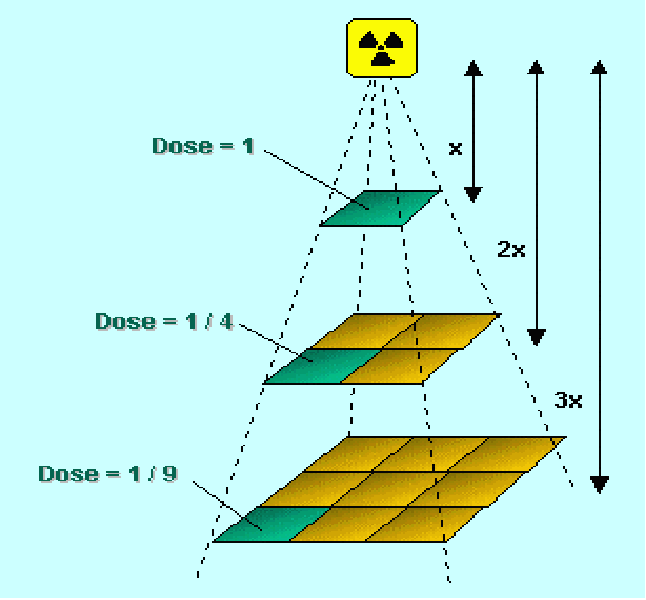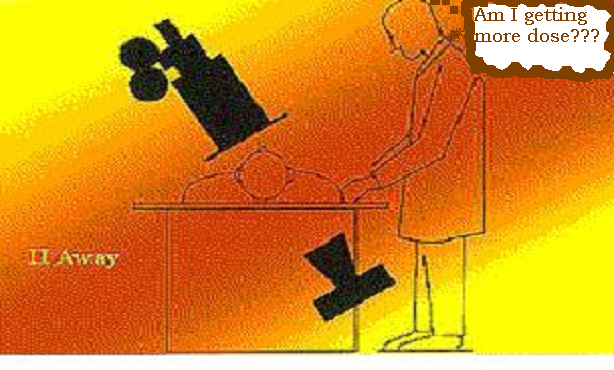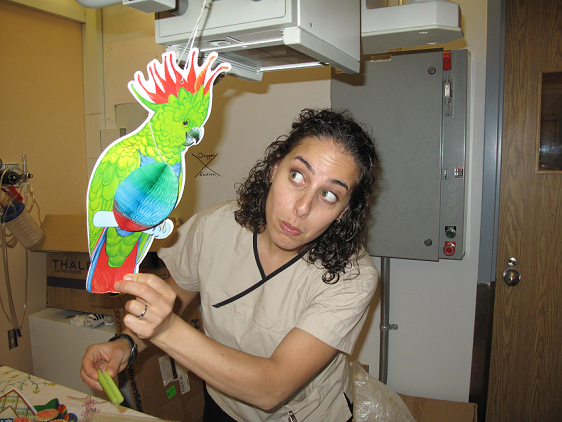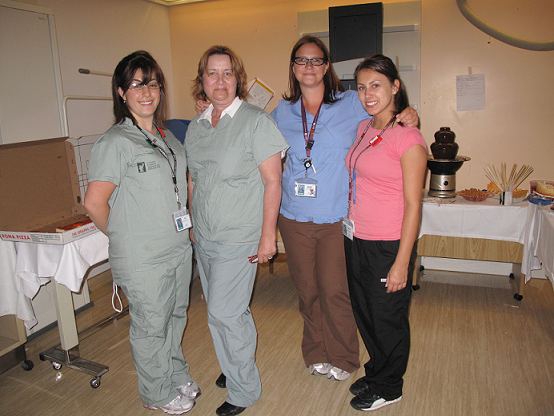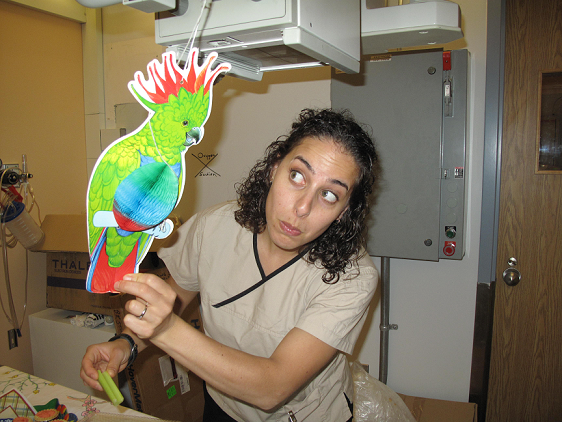Diagnostic Imaging (Hgh) - Radiation Safety Quiz
-
What are three general radiation safety practices to reduce dose? **HINT**
-
Placing the image intensifier as fa away from the patient as possible, never using collimation, keeping the x-ray tube as close to the patient as possible
-
Keeping the x-ray tube as far away from the patient as possible, using collimation, placing the image intensifier as far away from the patient as possible
-
Time, Distance and Sheilding
-
None of the above
-
This quiz is a refresher for radiation safety in the Diagnostic Imaging Department here at the General. For some of the questions, you should be able to reach deep inside your brain for the answer. For others, you may need to refer to the Radiation Safety Handout that I have provided for you.
Remember teamwork is always encouraged. :-)

Quiz Preview
- 2.
Which image below demonstrated the best method for hanging your lead?A. B. C. D.
-
A
-
B
-
C
-
D
Correct Answer
A. B -
- 3.
Where is the proper location to store badges/dosimeters after a shift?
-
On your yellow isolation gown that you were wearing because you were cold, that you left on a chair
-
On your lead apron that you were wearing
-
Take them home each and every night so that you know where they are at all times
-
Put it in the desognated TLD badge holders (ER X-ray and Locker Room) in non-radiation areas
-
Take it to your fishing derby so that you know where it is and it can also act as a fish ID tag too!
Correct Answer
A. Put it in the desognated TLD badge holders (ER X-ray and Locker Room) in non-radiation areasExplanation
The correct answer is to put the badges/dosimeters in the designated TLD badge holders in non-radiation areas. This ensures that the badges/dosimeters are stored in a secure and appropriate location after a shift, where they can be easily accessed and monitored. Storing them on the yellow isolation gown, on the lead apron, or taking them home each night is not the proper procedure and can lead to loss or damage of the badges/dosimeters. Taking them to a fishing derby is also not a suitable option as it can result in misplacement or improper use of the badges/dosimeters.Rate this question:
-
- 4.
When should collimation be used and what effect does it have on patient and staff exposure?
-
Never, it increase the patient exposure and scatter to staff
-
Always, it decreases patient exposure and reduces scatter to staff
-
Only in cases of padiatric patients, it decreases the patient exposure and scatter to staff
-
Only in cases of large patients, it decreases the patient exposure and scatter to staff
Correct Answer
A. Always, it decreases patient exposure and reduces scatter to staffExplanation
Collimation should always be used because it decreases patient exposure and reduces scatter to staff. Collimation refers to the process of restricting the size of the X-ray beam to only the area of interest, thereby minimizing unnecessary radiation exposure to the patient. By narrowing the X-ray beam, scatter radiation is also reduced, which further decreases the radiation dose to the staff. Therefore, using collimation is essential to ensure optimal image quality while minimizing radiation exposure to both the patient and the staff.Rate this question:
-
- 5.
If you currently wear a dosimeter at the Hamilton General and also work at another facility where you also wear a dosimeter you should:
-
Make sure that you don't mix them up when you have both sets at home on your kitchen table.
-
Notify Dr. Gerald Moran so that he can monitor your combined exposure
-
Notify Security here at the General
Correct Answer
A. Notify Dr. Gerald Moran so that he can monitor your combined exposureExplanation
If you wear a dosimeter at both the Hamilton General and another facility, it is important to notify Dr. Gerald Moran so that he can monitor your combined exposure. This is crucial because Dr. Moran will be able to assess the total amount of radiation you are exposed to from both facilities and ensure that it is within safe limits. By informing Dr. Moran, he can take necessary measures to protect your health and well-being. Notifying security at the Hamilton General may not be sufficient as they may not have the expertise or authority to monitor your combined exposure.Rate this question:
-
- 6.
Does the size of the patients have any effect on the radiation exposure to the patient and staff?
-
No, the size of the patient has no effect on the radiation exposure to the patient and staff
-
Yes, the larger the patient the higher the radiation exposure to the patient and the lower the radiation exposure to the staff becuase a larger amount of radiation is absorbed by the patient
-
Yes, the larger the patient the higher the technique that is needed resulting in an increase dose to patient and staff
Correct Answer
A. Yes, the larger the patient the higher the technique that is needed resulting in an increase dose to patient and staffExplanation
The correct answer is that the larger the patient, the higher the technique that is needed, resulting in an increase in dose to both the patient and staff. This is because larger patients require more radiation to penetrate through their body and produce clear images. As a result, the staff needs to use higher levels of radiation to obtain accurate diagnostic information, which increases the radiation exposure to both the patient and the staff.Rate this question:
-
- 7.
What is the Dose equivalent Annual Limit for the whole body for a radiation worker?
-
10 mSv
-
20 mSv
-
30 mSv
-
40 mSv
-
50 mSv
Correct Answer
A. 50 mSvExplanation
The dose equivalent annual limit for the whole body for a radiation worker is 50 mSv. This means that in a year, a radiation worker should not be exposed to more than 50 mSv of radiation. This limit is set to ensure the safety and health of the radiation worker, as exposure to higher levels of radiation can increase the risk of harmful effects such as cancer and other radiation-related illnesses.Rate this question:
-
- 8.
The dose rate at 4 feet from a radiation source is ________ times that of the dose rate at 8 feet from the radiation source.
-
2
-
3
-
4
-
8
Correct Answer
A. 4Explanation
The dose rate at 4 feet from a radiation source is four times that of the dose rate at 8 feet from the radiation source. This means that the radiation intensity decreases as the distance from the source increases. The inverse square law states that the intensity of radiation is inversely proportional to the square of the distance from the source. Therefore, if the dose rate is four times greater at 4 feet, it means that the intensity is four times greater at 4 feet compared to 8 feet.Rate this question:
-
- 9.
With respect to fluoscopy scatter, does the operator receive more dose to the eyes with the Image Intensifier away from the operator (diagram A) or with the Image intesifier closer to the operator (diagram B) Diagram ADiagram B
-
A
-
B
Correct Answer
A. AExplanation
The correct answer is A because when the Image Intensifier is away from the operator (diagram A), the scatter radiation has a longer distance to travel before reaching the operator's eyes. This results in a decrease in the dose of scatter radiation received by the operator's eyes compared to when the Image Intensifier is closer to the operator (diagram B).Rate this question:
-
- 10.
The x-ray tube should be placed ________ in order to minimze skin entrance dose rate to the pateint. The image intensifier should be _______ in order to decrease the skin entrance exposure rate to the patient and reduce scatter radiation to the staff.
-
As far away from the patient as possible / as close to the patient as possible
-
As close to the patient as possible / as close to the patient as possible
-
As far away from the patient as possible / as far away from the patient as possible
-
As close to the patient as possible / as far away from the patient as possible.
Correct Answer
A. As far away from the patient as possible / as close to the patient as possibleExplanation
The x-ray tube should be placed as far away from the patient as possible in order to minimize skin entrance dose rate to the patient. This is because the further the x-ray tube is from the patient, the greater the distance the radiation has to travel and the more it spreads out, reducing the dose received by the patient's skin. On the other hand, the image intensifier should be placed as close to the patient as possible in order to decrease the skin entrance exposure rate to the patient and reduce scatter radiation to the staff. This is because the image intensifier absorbs and converts the x-rays into a visible image, reducing the amount of radiation that reaches the patient's skin and the staff.Rate this question:
-
- 11.
TLD's must be turned in on time because if they are returned late:
-
The results may be overestimated since a control may not be subtracted
-
The results may be underestimated
-
A late charge will be assessed if the badge is not returned on time
-
A and C
Correct Answer
A. A and CExplanation
If TLD's (Thermoluminescent dosimeters) are returned late, the results may be overestimated since a control may not be subtracted and a late charge will be assessed if the badge is not returned on time. This means that if the TLD's are not turned in on time, there is a risk of inaccurate results and a financial penalty. Therefore, both options A and C are correct.Rate this question:
-
- 12.
With respect to pregnant workers, what is the maximum permissible dose to the abdomen during the course of the pregnancy?
-
1 mSv
-
2 mSv
-
5 mSv
-
10 mSv
Correct Answer
A. 5 mSvExplanation
During pregnancy, it is important to limit the exposure of the abdomen to radiation to protect the developing fetus. The maximum permissible dose to the abdomen during the course of pregnancy is 5 mSv. This limit is set to minimize the risk of harmful effects on the fetus while still allowing for necessary medical procedures that may involve radiation. Exceeding this dose limit can increase the risk of birth defects and developmental problems in the unborn child. Therefore, it is crucial to adhere to this maximum permissible dose to ensure the safety of both the mother and the fetus.Rate this question:
-
- 13.
Natural Background Radiation accounts for _______ mSv per year.
-
1-3
-
3-5
-
5-8
-
8-10
-
10-12
Correct Answer
A. 3-5Explanation
Natural Background Radiation refers to the radiation that is present in the environment from natural sources such as cosmic rays, radon gas, and radioactive materials in the Earth's crust. It is a constant exposure that everyone experiences on a daily basis. The average annual dose of Natural Background Radiation is typically in the range of 3-5 mSv. This level of radiation is considered to be relatively low and does not pose a significant health risk to individuals.Rate this question:
-
- 14.
What is the yearly maximum permissable dose to the skin for a radiation worker?
-
50 mSv
-
100 mSv
-
150 mSv
-
200 mSv
-
500 mSv
Correct Answer
A. 500 mSvExplanation
The yearly maximum permissible dose to the skin for a radiation worker is 500 mSv. This means that a radiation worker can be exposed to a maximum dose of 500 mSv to their skin in a year without exceeding the safe limit. It is important for radiation workers to adhere to this limit to minimize the risk of harmful effects from radiation exposure.Rate this question:
-
- 15.
What is the Fluoro Time reporting policy followed here at the General?
-
Umm.. I think that I will ask the bird again.
-
GI and portable c-arm procedures greater than 15 minutes and Angio/interventional procedures greater than 20 minutes.
-
GI and portable c-arm procedures greater than 20 minutes and Angio/interventional procedures greater than 30 minutes.
-
GI and portable c-arm procedures greater than 10 minutes and Angio/interventional procedures greater than 20 minutes.
Correct Answer
A. GI and portable c-arm procedures greater than 10 minutes and Angio/interventional procedures greater than 20 minutes.Explanation
The correct answer is "GI and portable c-arm procedures greater than 10 minutes and Angio/interventional procedures greater than 20 minutes." This means that for Fluoro Time reporting at the General, GI and portable c-arm procedures must be longer than 10 minutes, while Angio/interventional procedures must be longer than 20 minutes in order to be reported.Rate this question:
-
- 16.
Who is our Radiation Protection Officer (RPO) here at the General?
-
Me. Sandra Grollman
-
Dr. Gerald Moran
-
Dr. Ian Doris
-
Dr. Hema Choudur
Correct Answer
A. Dr. Ian DorisExplanation
Dr. Ian Doris is our Radiation Protection Officer (RPO) at the General.Rate this question:
-
- 17.
Who is our Radiation Safety Officer (RSO) here at the General?
-
Me. Sandra Grollman
-
Dr. Gerald Moran
-
Dr. Ian Doris
-
Dr. Hema Choudur
Correct Answer
A. Dr. Gerald Moran -
- 18.
If badges are not returned within 90 days of the end of the wear period then we are charged: (Start picking off the money tree....)
-
$5.96 each
-
$9.96 each
-
$15.96 each
-
$20.96 each
Correct Answer
A. $15.96 eachExplanation
If badges are not returned within 90 days of the end of the wear period, there is a charge of $15.96 each.Rate this question:
-
- 19.
What is the best way to reduce patient and staff exposure?
-
Wearing your lead apron
-
Keepig the image intensifier as close to the patient as possible
-
Keeping the beam time to a minimum
-
Increasing the distance from the radiation source for staff
-
Heeellloooo! Ask the bird... They always know.
Correct Answer
A. Keepig the image intensifier as close to the patient as possibleExplanation
Keeping the image intensifier as close to the patient as possible is the best way to reduce patient and staff exposure. By keeping the image intensifier close to the patient, the amount of radiation needed to obtain a clear image is minimized. This reduces the overall exposure to both the patient and the staff.Rate this question:
-
Quiz Review Timeline (Updated): Mar 22, 2023 +
Our quizzes are rigorously reviewed, monitored and continuously updated by our expert board to maintain accuracy, relevance, and timeliness.
-
Current Version
-
Mar 22, 2023Quiz Edited by
ProProfs Editorial Team -
Sep 24, 2009Quiz Created by
Sandragrollman
 Back to top
Back to top



